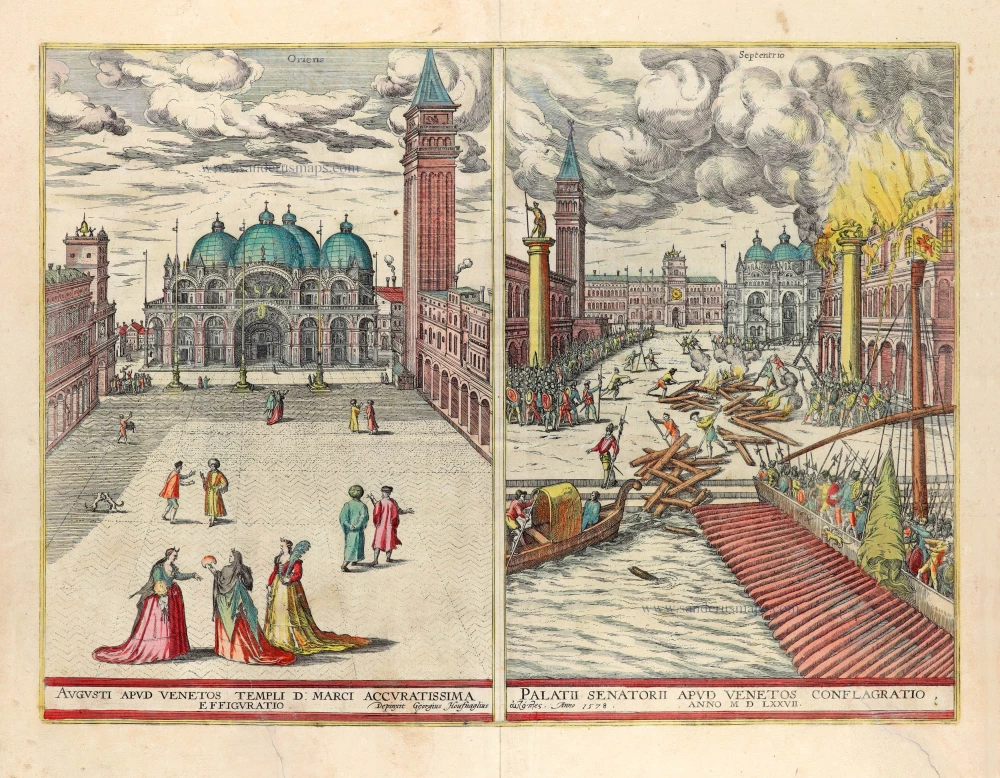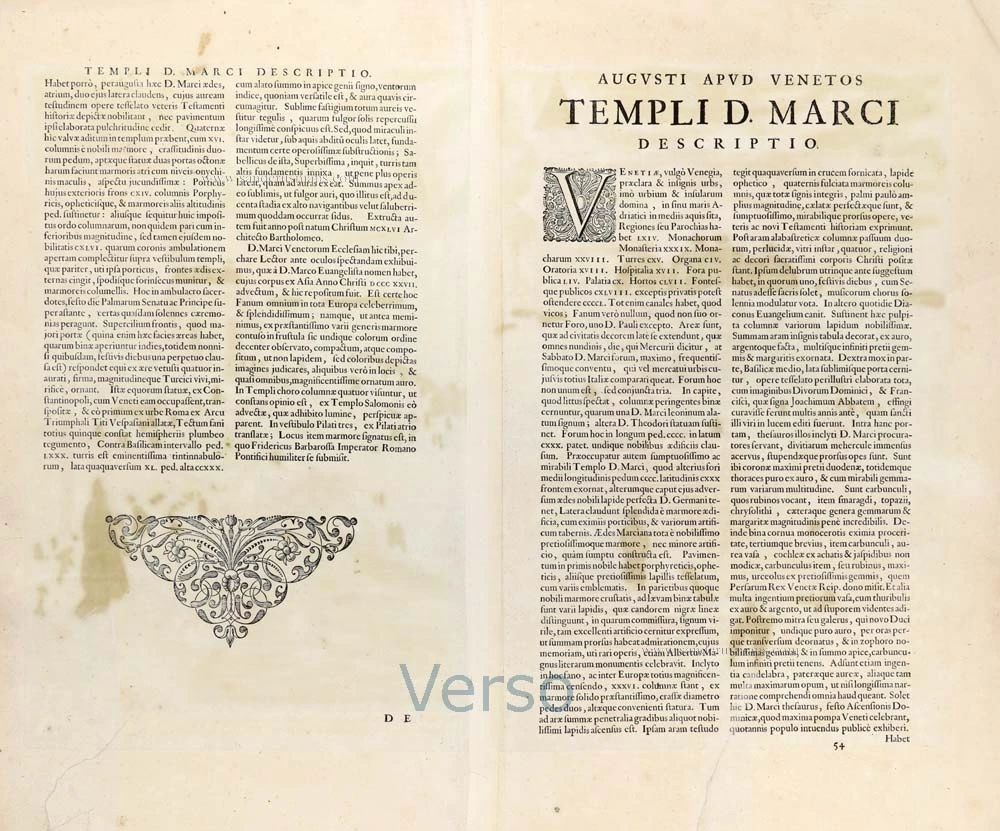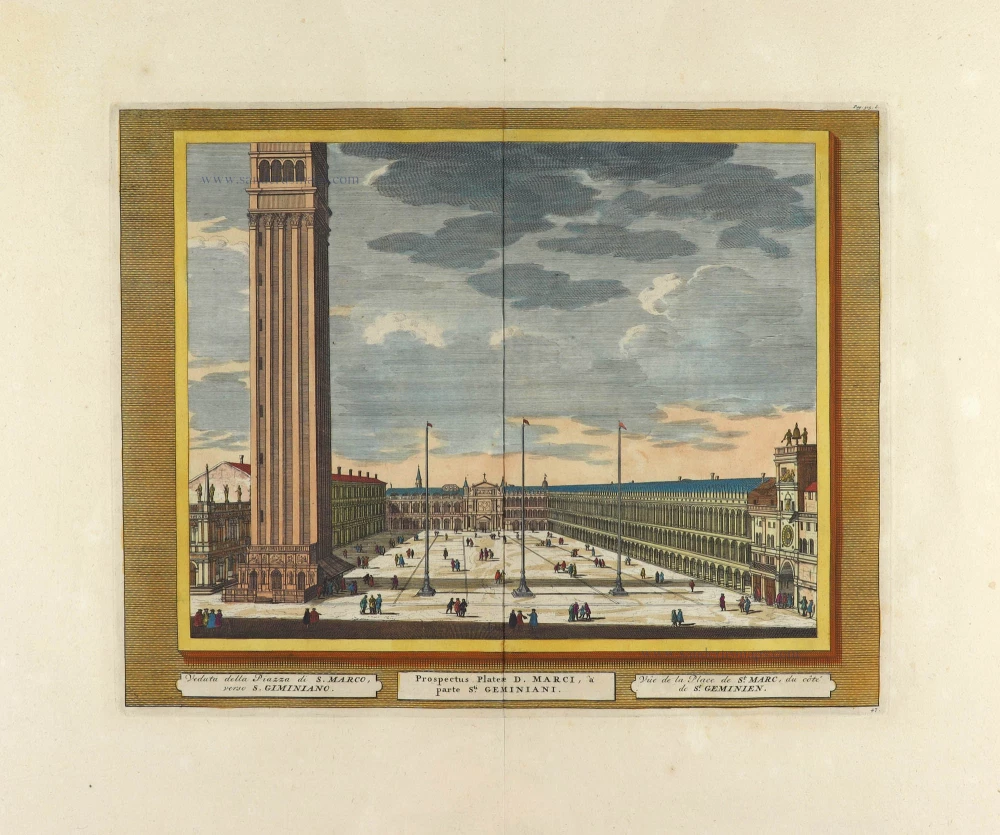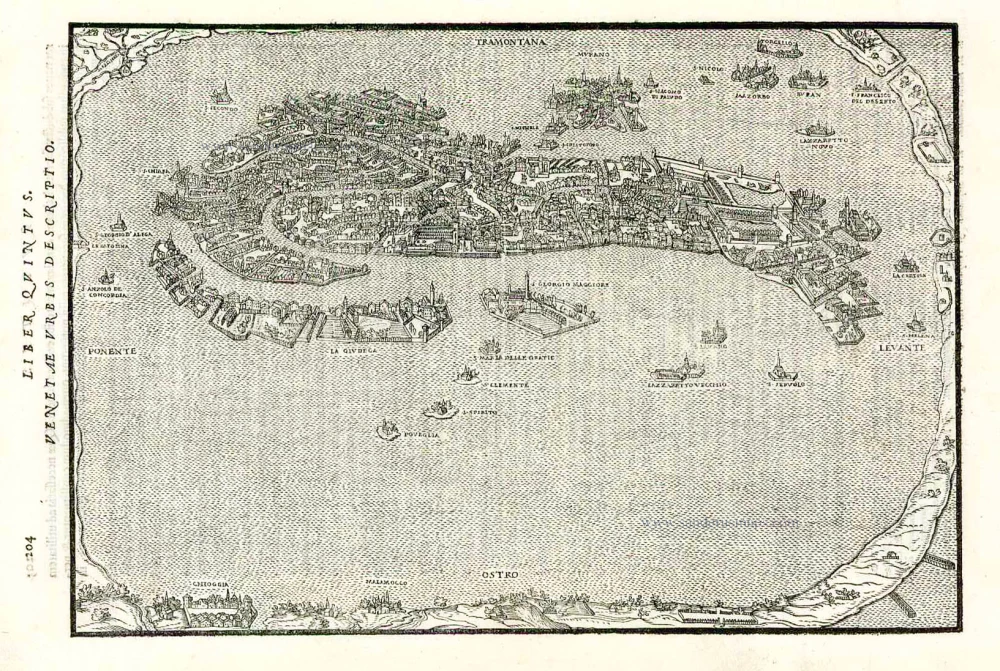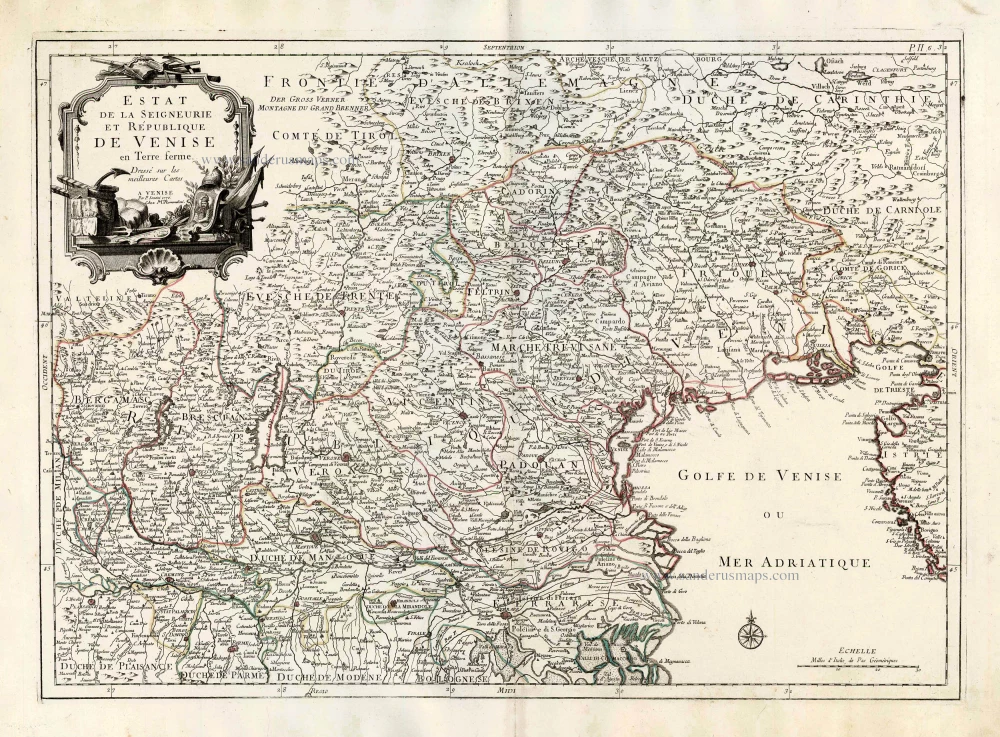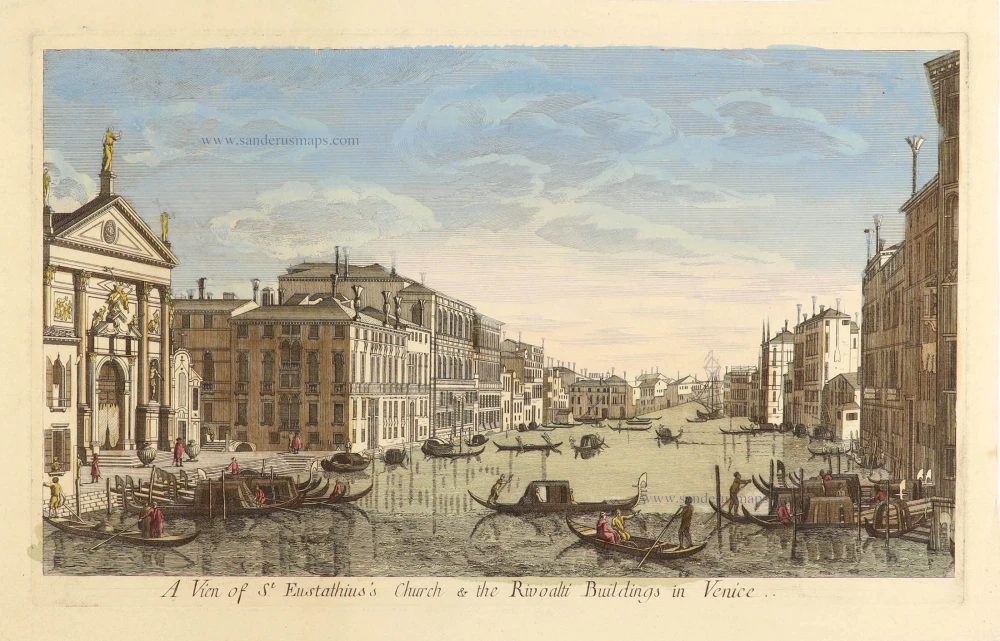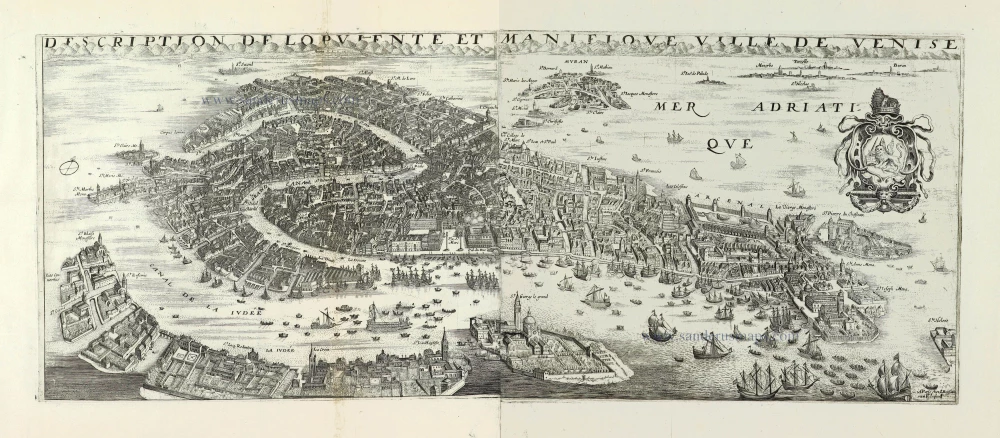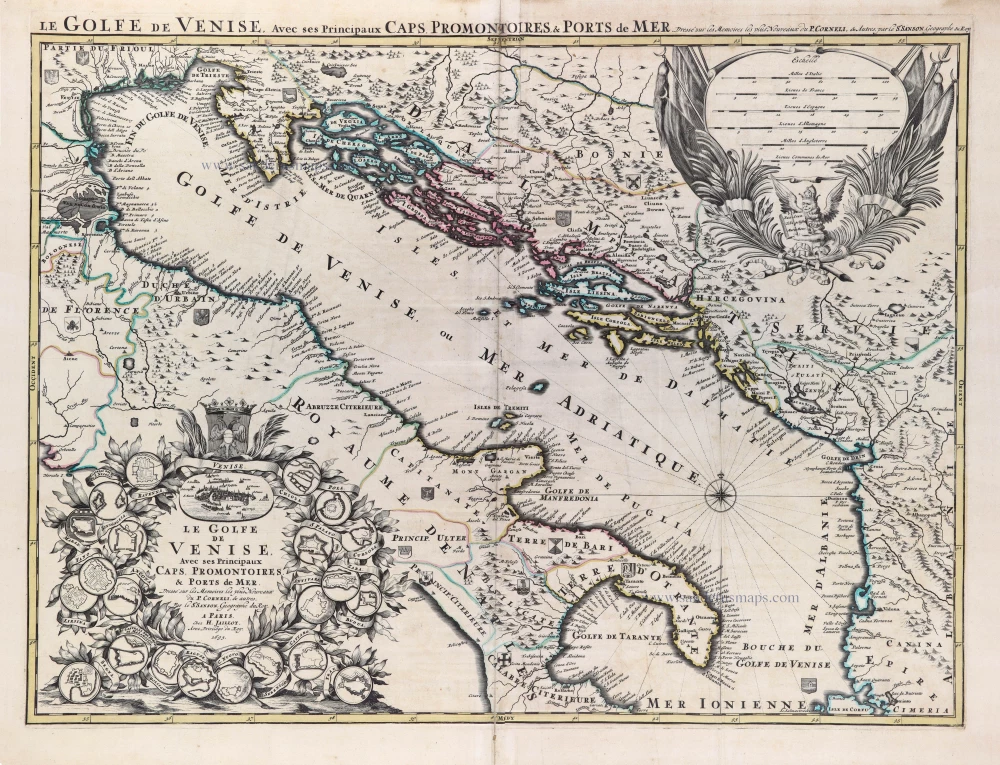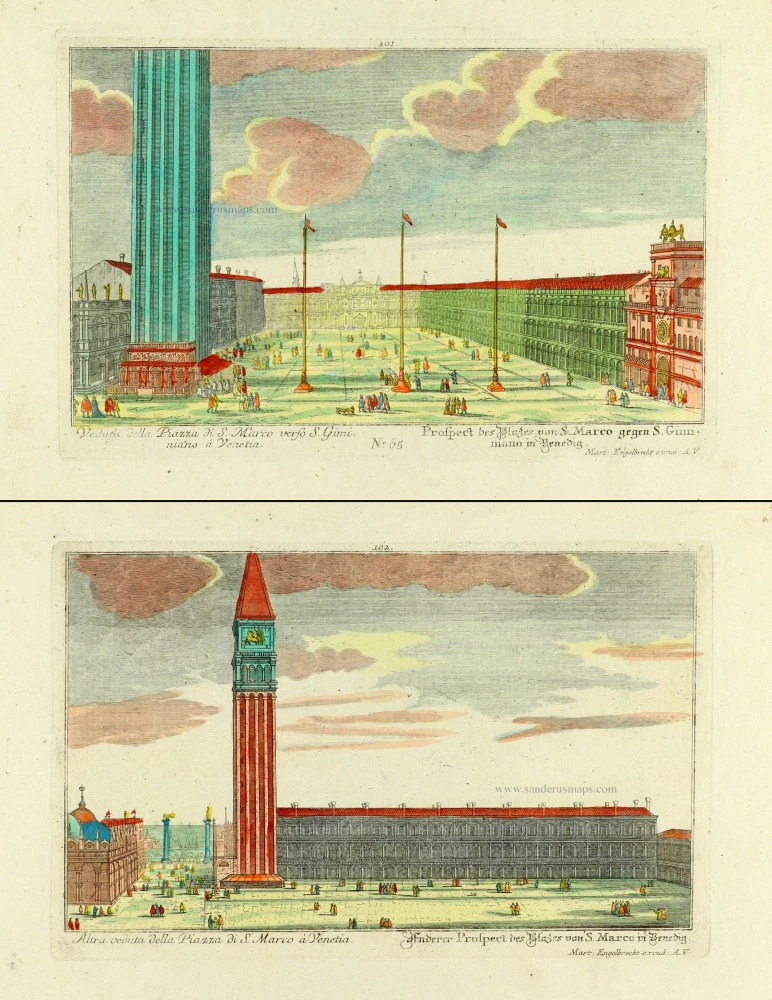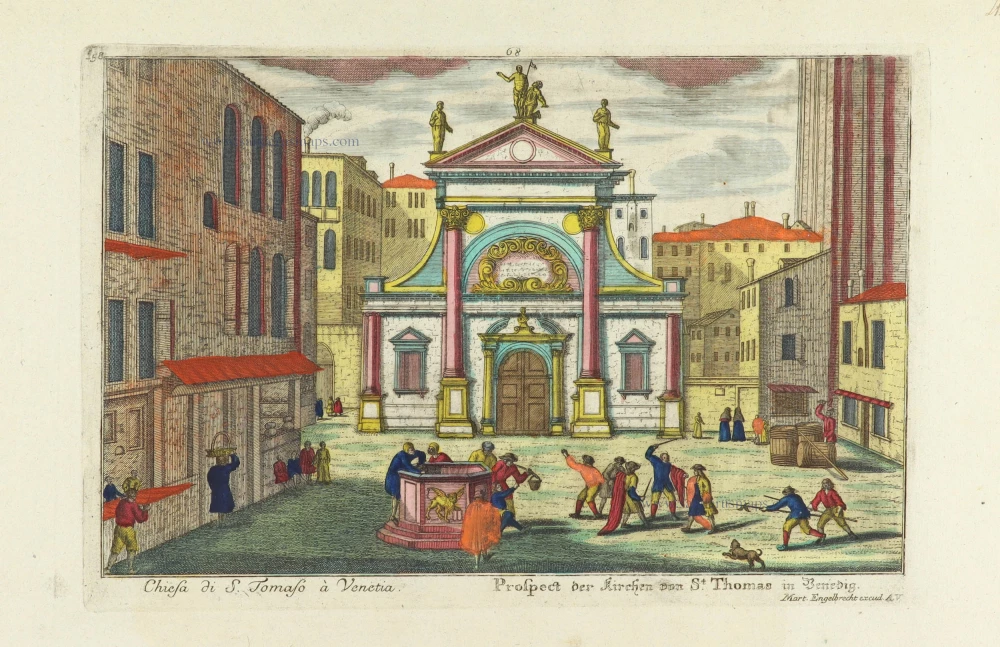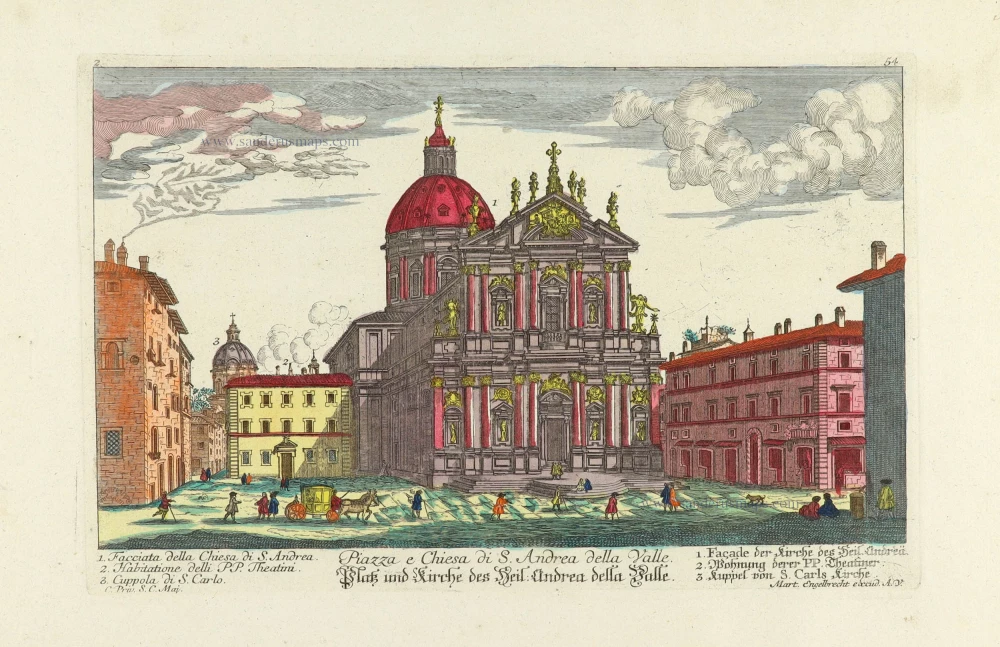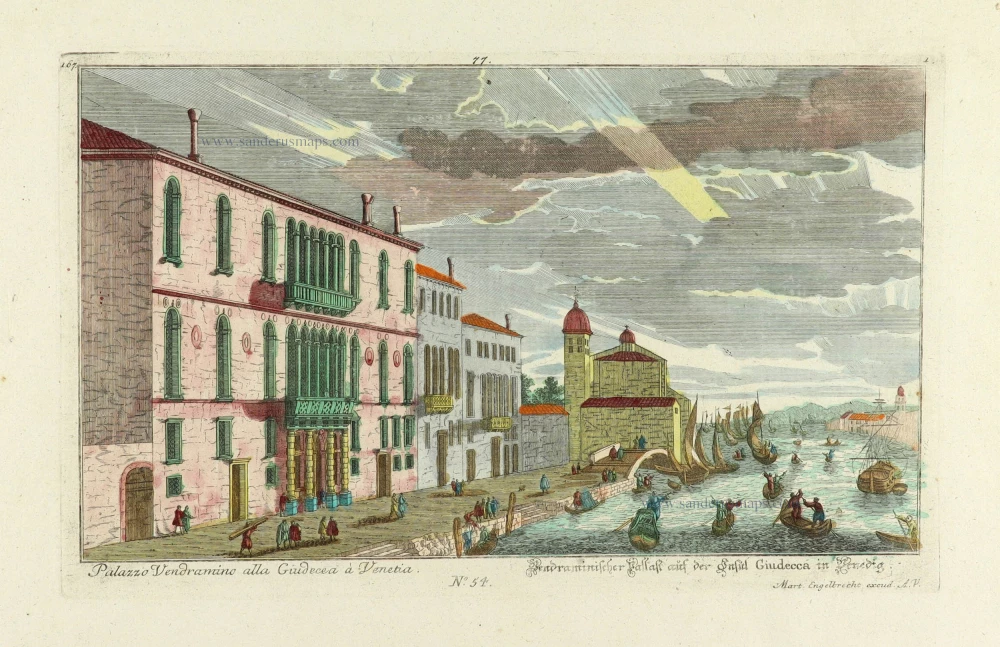Venice - Piazza San Marco and Piazetta, by Georg Braun and Frans Hogenberg, published by J. Janssonius. 1657
TRANSLATION OF CAPTION BOTTOM LEFT: Most accurate picture of the majestic Venetian church of St Mark.
SIGNED AND DATED BOTTOM CENTRE: Painted by Georg Hoefnagel, who saw it himself. In the year 1578.
CAPTION BOTTOM RIGHT: The fire at the Venetian Doge's palace in 1577.
COMMENTARY BY BRAUN (on verso): "St Mark's church is built of magnificent marble, skilfully and exquisitely inlaid with porphyry and other wonderful stones; the walls are clad with marble. [...] In this church, considered the most splendid in all Christendom, stand 36 columns of the best marble of a considerable height, two feet thick. [...] Behind the altar stand alabaster columns, each two paces apart, as transparent as glass. The altar is adorned with a wonderful panel of gold and silver inlaid with many pearls of inestimable value. [...] Above the large entrance portal (which has five doors altogether, of which two are open every day, the other two on feast days, but the fifth remains always shut) stand four beautiful gilt horses of copper or metal, like a Turkish horse in shape and size, quite wonderful to see. These are supposed to have been brought here from Constantinople when the Venetians took it."
On the left, we look across the piazza to the cathedral of San Marco, the Campanile dell'Orologio clock tower (left) and the Campanile bell tower (right). Our eye is guided to the magnificent façade of the San Marco with its five portals; the four of the cathedral's five roof domes visible here are indebted to Byzantine architecture. Above the central portal are the four horses of San Marco, the only surviving quadriga from Antiquity. The quadriga initially stood on the Arch of Nero in Rome but was taken by Constantine to Constantinople, where it was seized as booty in 1204 and transported to Venice. The right-hand scene shows the view of the Piazetta from the Grand Canal, with the Biblioteca Marciana on the left, the Campanile dell' Orologio in the centre, San Marco to the right and the burning Doge's palace on the far right. The raging fire is convincingly depicted in all its drama, with rescue forces arriving from all sides to tackle the blaze. Troops are waiting on the left even as a galley lands additional forces in the right-hand foreground; in the centre, rescue workers are trying to dowse the wooden panelling flung out of the palace, some still in flames. The seat of the Doge and the council of the Venetian Republic from the 9th century, the Doge's palace was rebuilt between the 13th and the 15th century in a style that determined the harmonious face of St Mark's Square. It was destroyed by fire on several occasions, including in 1577, when Hoefnagel visited Italy and witnessed this catastrophe first-hand. (Taschen)
The Janssonius Family
Joannes Janssonius (Arnhem, 1588-1664), son of the Arnhem publisher Jan Janssen, married Elisabeth Hondius, daughter of Jodocus Hondius, in Amsterdam in 1612. After his marriage, he settled down in this town as a bookseller and publisher of cartographic material. In 1618, he established himself in Amsterdam next door to Blaeu’s bookshop. He entered into serious competition with Willem Jansz. Blaeu when copying Blaeu’s Licht der Zeevaert after the expiration of the privilege in 1620. His activities concerned the publication of atlases, books, single maps, and an extensive book trade with branches in Frankfurt, Danzig, Stockholm, Copenhagen, Berlin, Koningsbergen, Geneva, and Lyon. In 1631, he began publishing atlases together with Henricus Hondius.
In the early 1640s, Henricus Hondius left the atlas publishing business to Janssonius. Competition with Joan Blaeu, Willem’s son and successor, in atlas production, prompted Janssonius to enlarge his Atlas Novus finally into a work of six volumes, into which a sea atlas and an atlas of the Old World were inserted. Other atlases published by Janssonius are Mercator’s Atlas Minor, Hornius’s historical atlas (1652), the townbooks in eight volumes (1657), Cellarius’s Atlas Coelestis and several sea atlases and pilot guides.
After the death of Joannes Janssonius, the shop and publishing firm were continued by the heirs under the direction of Johannes van Waesbergen (c. 1616-1681), son-in-law of Joannes Janssonius. Van Waesbergen added Janssonius's name to his own.
In 1676, Joannes Janssonius’s heirs sold by auction “all the remaining Atlases in Latin, French, High and Low German, as well as the Stedeboecken in Latin, in 8 volumes, bound and unbound, maps, plates belonging to the Atlas and Stedeboecken.” The copperplates from Janssonius’s atlases were afterwards sold to Schenk and Valck.
Braun G. & Hogenberg F. and the Civitates Orbis Terrarum.
The Civitates Orbis Terrarum, also known as the 'Braun & Hogenberg', is a six-volume town atlas and the most excellent book of town views and plans ever published: 363 engravings, sometimes beautifully coloured. It was one of the best-selling works in the last quarter of the 16th century. Georg Braun, a skilled writer, wrote the text accompanying the plans and views on the verso. Many plates were engraved after the original drawings of a professional artist, Joris Hoefnagel (1542-1600). The first volume was published in Latin in 1572 and the sixth in 1617. Frans Hogenberg, a talented engraver, created the tables for volumes I through IV, and Simon van den Neuwel made those for volumes V and VI. Other contributors were cartographers Daniel Freese and Heinrich Rantzau, who provided valuable geographical information. Works by Jacob van Deventer, Sebastian Münster, and Johannes Stumpf were also used as references. Translations appeared in German and French, making the atlas accessible to a broader audience.
Since its original publication of volume 1 in 1572, the Civitates Orbis Terrarum has left an indelible mark on the history of cartography. Seven more editions followed the first volume in 1575, 1577, 1582, 1588, 1593, 1599, and 1612. Vol.2, initially released in 1575, saw subsequent editions in 1597 and 1612. The subsequent volumes, each a treasure trove of historical insights, graced the world in 1581, 1588, 1593, 1599, and 1606. The German translation of the first volume, a testament to its widespread appeal, debuted in 1574, followed by the French edition in 1575.
Several printers were involved: Theodor Graminaeus, Heinrich von Aich, Gottfried von Kempen, Johannis Sinniger, Bertram Buchholtz, and Peter von Brachel, all of whom worked in Cologne.
Georg Braun (1541-1622)
Georg Braun, the author of the text accompanying the plans and views in the Civitates Orbis Terrarum, was born in Cologne in 1541. After his studies in Cologne, he entered the Jesuit Order as a novice, indicating his commitment to learning and intellectual pursuits. In 1561, he obtained his bachelor's degree; in 1562, he received his Magister Artium, further demonstrating his academic achievements. Although he left the Jesuit Order, he continued his studies in theology, gaining a licentiate in theology. His theological background likely influenced the content and tone of the text in the Civitates Orbis Terrarum, adding a unique perspective to the work.
Frans Hogenberg (1535-1590)
Frans Hogenberg was a Flemish and German painter, engraver, and mapmaker. He was born in Mechelen as the son of Nicolaas Hogenberg.
By the end of the 1560s, Frans Hogenberg was employed upon Abraham Ortelius's Theatrum Orbis Terrarum, published in 1570; he is named an engraver of numerous maps. In 1568, he was banned from Antwerp by the Duke of Alva and travelled to London, where he stayed a few years before emigrating to Cologne. He immediately embarked on his two most important works, the Civitates, published in 1572 and the Geschichtsblätter, which appeared in several series from 1569 until about 1587.
Thanks to large-scale projects like the Geschichtsblätter and the Civitates, Hogenberg's social circumstances improved with each passing year. He died as a wealthy man in Cologne in 1590.
Augusti apud Venetos Templi D: Marci Accuratissima Effiguratio [on sheet with] Palatii Senatorii apud Venetos conflagratio Anno MDLXXVII.
Item Number: 31096 Authenticity Guarantee
Category: Antique maps > Europe > Italy - Cities
Venice - Piazza San Marco and Piazetta, by Georg Braun and Frans Hogenberg, published by J. Janssonius.
The right view shows the fire in the Senator's Palace of 1577.
Title: Augusti apud Venetos Templi D: Marci Accuratissima Effiguratio [on sheet with:] Palatii Senatorii apud Venetos conflagratio Anno MDLXXVII.
Depinxit Georgius Houfnaglius ... [greek] ... anno 1578.
Designer: Georg Hoefnagel.
Date of the first edition: 1596.
Date of this map: 1657.
Date on map: 1578.
Copper engraving, printed on paper.
Image size: 365 x 490mm (14.37 x 19.29 inches).
Sheet size: 405 x 530mm (15.94 x 20.87 inches).
Verso: Latin text.
Condition: Original coloured, two tears closed in the bottom margin.
Condition Rating: A
From: Theatrum Celebriorum Urbium Italiae, aliarumque in Insulis Maris Mediterranei. Amsterdam, J. Janssonius [1657]. (Van der Krogt 4, p. 282, 42:15)
TRANSLATION OF CAPTION BOTTOM LEFT: Most accurate picture of the majestic Venetian church of St Mark.
SIGNED AND DATED BOTTOM CENTRE: Painted by Georg Hoefnagel, who saw it himself. In the year 1578.
CAPTION BOTTOM RIGHT: The fire at the Venetian Doge's palace in 1577.
COMMENTARY BY BRAUN (on verso): "St Mark's church is built of magnificent marble, skilfully and exquisitely inlaid with porphyry and other wonderful stones; the walls are clad with marble. [...] In this church, considered the most splendid in all Christendom, stand 36 columns of the best marble of a considerable height, two feet thick. [...] Behind the altar stand alabaster columns, each two paces apart, as transparent as glass. The altar is adorned with a wonderful panel of gold and silver inlaid with many pearls of inestimable value. [...] Above the large entrance portal (which has five doors altogether, of which two are open every day, the other two on feast days, but the fifth remains always shut) stand four beautiful gilt horses of copper or metal, like a Turkish horse in shape and size, quite wonderful to see. These are supposed to have been brought here from Constantinople when the Venetians took it."
On the left, we look across the piazza to the cathedral of San Marco, the Campanile dell'Orologio clock tower (left) and the Campanile bell tower (right). Our eye is guided to the magnificent façade of the San Marco with its five portals; the four of the cathedral's five roof domes visible here are indebted to Byzantine architecture. Above the central portal are the four horses of San Marco, the only surviving quadriga from Antiquity. The quadriga initially stood on the Arch of Nero in Rome but was taken by Constantine to Constantinople, where it was seized as booty in 1204 and transported to Venice. The right-hand scene shows the view of the Piazetta from the Grand Canal, with the Biblioteca Marciana on the left, the Campanile dell' Orologio in the centre, San Marco to the right and the burning Doge's palace on the far right. The raging fire is convincingly depicted in all its drama, with rescue forces arriving from all sides to tackle the blaze. Troops are waiting on the left even as a galley lands additional forces in the right-hand foreground; in the centre, rescue workers are trying to dowse the wooden panelling flung out of the palace, some still in flames. The seat of the Doge and the council of the Venetian Republic from the 9th century, the Doge's palace was rebuilt between the 13th and the 15th century in a style that determined the harmonious face of St Mark's Square. It was destroyed by fire on several occasions, including in 1577, when Hoefnagel visited Italy and witnessed this catastrophe first-hand. (Taschen)
The Janssonius Family
Joannes Janssonius (Arnhem, 1588-1664), son of the Arnhem publisher Jan Janssen, married Elisabeth Hondius, daughter of Jodocus Hondius, in Amsterdam in 1612. After his marriage, he settled down in this town as a bookseller and publisher of cartographic material. In 1618, he established himself in Amsterdam next door to Blaeu’s bookshop. He entered into serious competition with Willem Jansz. Blaeu when copying Blaeu’s Licht der Zeevaert after the expiration of the privilege in 1620. His activities concerned the publication of atlases, books, single maps, and an extensive book trade with branches in Frankfurt, Danzig, Stockholm, Copenhagen, Berlin, Koningsbergen, Geneva, and Lyon. In 1631, he began publishing atlases together with Henricus Hondius.
In the early 1640s, Henricus Hondius left the atlas publishing business to Janssonius. Competition with Joan Blaeu, Willem’s son and successor, in atlas production, prompted Janssonius to enlarge his Atlas Novus finally into a work of six volumes, into which a sea atlas and an atlas of the Old World were inserted. Other atlases published by Janssonius are Mercator’s Atlas Minor, Hornius’s historical atlas (1652), the townbooks in eight volumes (1657), Cellarius’s Atlas Coelestis and several sea atlases and pilot guides.
After the death of Joannes Janssonius, the shop and publishing firm were continued by the heirs under the direction of Johannes van Waesbergen (c. 1616-1681), son-in-law of Joannes Janssonius. Van Waesbergen added Janssonius's name to his own.
In 1676, Joannes Janssonius’s heirs sold by auction “all the remaining Atlases in Latin, French, High and Low German, as well as the Stedeboecken in Latin, in 8 volumes, bound and unbound, maps, plates belonging to the Atlas and Stedeboecken.” The copperplates from Janssonius’s atlases were afterwards sold to Schenk and Valck.
Braun G. & Hogenberg F. and the Civitates Orbis Terrarum.
The Civitates Orbis Terrarum, also known as the 'Braun & Hogenberg', is a six-volume town atlas and the most excellent book of town views and plans ever published: 363 engravings, sometimes beautifully coloured. It was one of the best-selling works in the last quarter of the 16th century. Georg Braun, a skilled writer, wrote the text accompanying the plans and views on the verso. Many plates were engraved after the original drawings of a professional artist, Joris Hoefnagel (1542-1600). The first volume was published in Latin in 1572 and the sixth in 1617. Frans Hogenberg, a talented engraver, created the tables for volumes I through IV, and Simon van den Neuwel made those for volumes V and VI. Other contributors were cartographers Daniel Freese and Heinrich Rantzau, who provided valuable geographical information. Works by Jacob van Deventer, Sebastian Münster, and Johannes Stumpf were also used as references. Translations appeared in German and French, making the atlas accessible to a broader audience.
Since its original publication of volume 1 in 1572, the Civitates Orbis Terrarum has left an indelible mark on the history of cartography. Seven more editions followed the first volume in 1575, 1577, 1582, 1588, 1593, 1599, and 1612. Vol.2, initially released in 1575, saw subsequent editions in 1597 and 1612. The subsequent volumes, each a treasure trove of historical insights, graced the world in 1581, 1588, 1593, 1599, and 1606. The German translation of the first volume, a testament to its widespread appeal, debuted in 1574, followed by the French edition in 1575.
Several printers were involved: Theodor Graminaeus, Heinrich von Aich, Gottfried von Kempen, Johannis Sinniger, Bertram Buchholtz, and Peter von Brachel, all of whom worked in Cologne.
Georg Braun (1541-1622)
Georg Braun, the author of the text accompanying the plans and views in the Civitates Orbis Terrarum, was born in Cologne in 1541. After his studies in Cologne, he entered the Jesuit Order as a novice, indicating his commitment to learning and intellectual pursuits. In 1561, he obtained his bachelor's degree; in 1562, he received his Magister Artium, further demonstrating his academic achievements. Although he left the Jesuit Order, he continued his studies in theology, gaining a licentiate in theology. His theological background likely influenced the content and tone of the text in the Civitates Orbis Terrarum, adding a unique perspective to the work.
Frans Hogenberg (1535-1590)
Frans Hogenberg was a Flemish and German painter, engraver, and mapmaker. He was born in Mechelen as the son of Nicolaas Hogenberg.
By the end of the 1560s, Frans Hogenberg was employed upon Abraham Ortelius's Theatrum Orbis Terrarum, published in 1570; he is named an engraver of numerous maps. In 1568, he was banned from Antwerp by the Duke of Alva and travelled to London, where he stayed a few years before emigrating to Cologne. He immediately embarked on his two most important works, the Civitates, published in 1572 and the Geschichtsblätter, which appeared in several series from 1569 until about 1587.
Thanks to large-scale projects like the Geschichtsblätter and the Civitates, Hogenberg's social circumstances improved with each passing year. He died as a wealthy man in Cologne in 1590.

